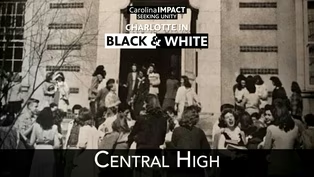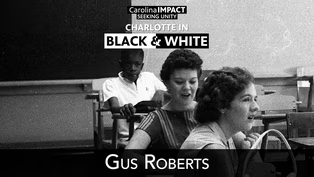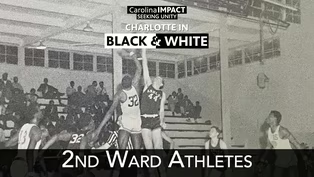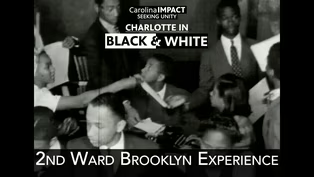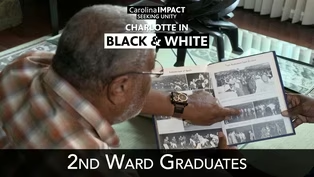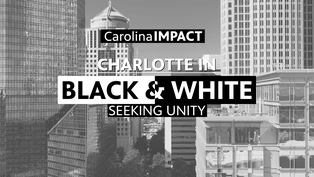
Seeking Unity: Charlotte In Black & White
Season 11 Episode 1130 | 28m 45sVideo has Closed Captions
Once segregated by race, a community comes together to learn from it's fractured past.
We take you into a world that looks and feels very different from what we know today… a world that was once segregated by race. But now the community is coming together to reflect on the joy and pain… but, most importantly, learn from the past to create a future that brings everyone together.
Problems playing video? | Closed Captioning Feedback
Problems playing video? | Closed Captioning Feedback
Carolina Impact is a local public television program presented by PBS Charlotte

Seeking Unity: Charlotte In Black & White
Season 11 Episode 1130 | 28m 45sVideo has Closed Captions
We take you into a world that looks and feels very different from what we know today… a world that was once segregated by race. But now the community is coming together to reflect on the joy and pain… but, most importantly, learn from the past to create a future that brings everyone together.
Problems playing video? | Closed Captioning Feedback
How to Watch Carolina Impact
Carolina Impact is available to stream on pbs.org and the free PBS App, available on iPhone, Apple TV, Android TV, Android smartphones, Amazon Fire TV, Amazon Fire Tablet, Roku, Samsung Smart TV, and Vizio.

Introducing PBS Charlotte Passport
Now you can stream more of your favorite PBS shows including Masterpiece, NOVA, Nature, Great British Baking Show and many more — online and in the PBS Video app.Providing Support for PBS.org
Learn Moreabout PBS online sponsorship(gentle upbeat music) - [Voice Over] This is a production of PBS Charlotte.
- [Voice Over] This week on a special CarolinaIMPACT: Seeking Unity.
- They had to tough it out and they made history.
- [Voice Over] The hundred year history of two Charlotte schools.
close together, but worlds apart.
- [Ted] This is me.
- [Voice Over] One school just for black students.
- That's when I really found out about prejudice.
- They put in us how to respect others.
- [Voice Over] And one school just for white students.
- Lots of rivalries but lots of friendships developed too.
- I still have my cheerleader outfit.
I could go check and see.
- Both schools now gone.
- I always think if I could hear voices of the past, like what would they be calling out to me and saying?
- [Voice Over] But not forgotten.
- It was a privilege and it was also an experience that I'll never forget.
- [Voice Over] Tonight, CarolinaIMPACT looks back at Charlotte in Black & White.
(dramatic music) - Welcome to our Seeking Unity Special, I'm Dara Khaalid.
Every new school year brings new excitement for kids in the classroom, but in Charlotte, a century of school history, brings all of us a little reflection too, about where we've been and what we've learned in the last hundred years.
CarolinaIMPACT's Bea Thompson, takes us back to the beginning of Charlotte's first all black high school and the neighborhood that brought it to life.
(air whooshing) (gentle music) - That sense of belonging, that sense of humanness that we had as one, was always the Brooklyn, really Second Ward story.
- [Bea] You may have heard of the storied Brooklyn community in the heart of uptown Charlotte and the high school that was its heartbeat, that would be Second Ward.
- It's a school that was very well needed, and it's very well missed.
I tell you the learning at that school, it was phenomenal.
It didn't get any better than that.
- [Bea] Romanticizing the past?
Not for these former students and residents of Second Ward and the Brooklyn community.
- [Ted] This is me.
This is Ted Kennedy.
- [Bea] For their school years happened during a segregated time in America, and it was the community and the school, that sheltered and nurtured young black children.
- When I went to South (indistinct) I was always told I was not gonna be able to go to college and I should not even be in any of the academic programs.
This was from the counselor.
(upbeat music) - [Bea] Yet at Second Ward, her teachers immediately dispelled that idea.
- But when I got to Second Ward, they said, who told you that?
(laughs) And so that's when I changed everything and I went to college.
(laughs) - [Bea] And it was that type of caring in the schoolhouse, that carried over into the community.
- Whatever we did, the community will always join in.
When we had fundraisers, they would always participate with us.
So there are a lot of things, that allowed the community to connect with us, on a social aspect and business aspect.
- [Bea] From yearbook ads by businesses to jobs for students.
Ask anyone today and they can call off those businesses and their locations.
- We would stop at McKenzie's Shoe Shop.
That's where you drop your shoes off.
The barbershop was there, which was the Tate family, and then the pharmacy.
Philip's pharmacy was right there.
You'd stop there and you could go in there for that.
And of course the movie theater was there.
- My father had his business at the corner of (indistinct).
Also, he had an auto mechanic shop, so he was the neighborhood mechanic.
- [Bea] And in the neighborhoods of Brooklyn, Cherry and First Ward, children learn from the cross section of families in their community.
- Within a neighborhood, you could have a school teacher at one house, you could have a minister at another, and then you could have someone with no degree at all, all living right there.
- [Bea] Yet it always comes back to Second Ward High School.
- [Eloise] It's so sweet.
[Voice Over] And it's pivotal impact in their lives.
- They were still like, (indistinct) you can do it.
Come on now.
Go back out there.
(laughs) We are not giving up on you.
All the people and all the young ladies, that were just aspiring to be better and wanting to do better, 'cause that's what I wanted to do.
I wanted to do better and be better than what I had ever thought that I could be.
- This is such a good experience.
It is one of those things that you just can't duplicate.
You have to really live it to understand what good it was.
- We were always taught whatever happens to you, whatever goes on wherever you are, if somebody says Second Ward, stop what you're doing and go and help them.
- [Bea] Yet, within a few years, the vibrant community of Brooklyn and its storied Second Ward High School, would both meet their demise through a federal program termed urban renewal.
- And the whole community was gone.
It still hurts.
It's one of those things you have to get used to, or get beyond.
But when you think about it, it's still painful.
- The other loss, I think, was in the explanations given to the persons who lost their homes and who had to move and who had to do something like that.
Promises made about, I believe when Second Ward was torn down, "We're going to build a new school, don't worry about it."
Well, that never happened.
- They made a lot of promises during graduation, that they was gonna build another school, but I didn't feel like there would be another school built because of the location where it was.
- [Bea] Today, much of the memorabilia of those days, is stored at the Second Ward Alumni house, where many reminisce about their school and community.
- We all did well survive, which is good and we carry on that kind of importance of that legacy.
- [Bea] So how did they fare in life?
The country girl who moved to the city, did go on to college, Wilberforce in Ohio, and more than 50 years later, she still married to her Second Ward sweetheart, who was an athlete.
Natalie Kennedy Beard went to Spelman and became a Professor of Education at Harris-Stowe State University in St. Louis.
- [Jacqueline] Right here.
- [Bea] Jacqueline Fullman Gunter went to North Carolina A&T became a teacher and taught at a school, with some of her former Second Ward teachers.
And Ted Kennedy went on to become a CMPD officer and a detective.
For many of the former students of Second Ward, the nurturing allowed them to spread their wings in life, while never forgetting their Second Ward roots.
- As Bea mentioned, these old black and white photos are all that's left of the original Second Ward High school, but just a few blocks away, CarolinaIMPACT's Jeff Sonier and videographer, Doug Stacker, take us inside Charlotte's other century-old school, that also opened that same day in 1923.
- Yeah, for decades here at Central High School, this is where every school day began, walking up these front steps.
And a hundred years later, well, this is where the memories start too.
(gentle music) - Every time I enter that building, I always think, "If I could hear voices of the past, what would they be calling out to me and saying?"
(bell rings) Or would I hear a bell ring?
Or I just always think of stepping in the same spot, maybe, where there is real connection, with people who have come before us.
- [Jeff] Erin Allsop, the archivist, for Central Piedmont Community College, has a view of this oldest building on campus from her office window, and the newest building on campus right next door, where the college is curating the a hundred year history of Central High and Second Ward High too.
(gentle music) - We didn't live this experience, this is just our way of telling the stories of others, who experienced it for themselves.
- [Jeff] Allsop gives us a private peek at what may be the rarest item in her collection.
- So this is leather, it's a leather bound or a suede bound book, rather.
- [Jeff] This Snips and Cuts yearbook from 1911, 12 years before the old Charlotte High School relocated in 1923, to the new Central High School.
Also on display, is Anna Elizabeth Sutton's diploma from 1928, the second four year class to graduate from Central High.
The diploma itself, hidden away, for who knows how long, in the home of a Sutton relative.
- And he's walking on campus with this big frame and came in and said, "I wanna donate this to you.
This is still here."
- [Jeff] That Central High Legacy includes decades more of these donated scrapbook memories, lots of Charlotte and black and white reminders of what life was like for Central High graduates and their families.
Most memorable may be this old hand me down high school cheerleading sweater, which I mean it's beautifully detailed and beautifully crafted.
- [Jeff] And beautifully preserved too.
Allsop showing us the sweater's woven patches on the front and on the back and look closely on the sweater's collar, where you can still see this old pink tag from the dry cleaners.
- Yeah, I'm a cheerleader.
I still have my cheerleader outfit.
I could go check and see.
- [Jeff] Yep, former Charlotte Mayor and City Council member Patsy Kinsey, was a Central High cheerleader too.
Class of '59, 28 years after her mother also graduated from Central.
- My homeroom teacher I think, was her Latin teacher at Central.
- Wow, so it was kind of a family tradition for you, Central High School, yeah.
- And I think when I went there, the school pretty much looked the way it did, when she was there.
- Kinsey adds, that's pretty much, what Central High School looks like today.
After the restoration renovation and rededication of the old building, that she and other graduates pushed for back in 2007.
They even replanted a willow tree out front, to replace Central High's original 1923 willow tree at the school's reunion, celebrating Central High's reopening.
- It was so exciting, exciting to be on the grounds there at Central Piedmont Community College.
- In fact, the old Central High building is where Central Piedmont actually started, back in the early '60s.
Central High was also the original campus for Charlotte College, which eventually became UNC Charlotte.
- I would say that my fondest memory of all of that building, attending Central High School, was the fact that Charlotte College was in the basement of the building.
- [Jeff] That's Charlotte sports writer, author, and talk show host John Kilgo, class of '55, who went to high school and college in this old building.
He was one of several Central High graduates, interviewed by UNC Charlotte, prior to that 2007 reunion.
- Lots of rivalries, but lots of friendships developed too.
- [Jeff] Former TV executive, Jim Babb, class of '51, remembers those old central football games at Memorial Stadium.
- Lived across the street from the school most of my life.
- [Jeff] And longtime Charlotte Observer Editor, Jack Claiborne, Central High class of '50, says Charlotte's largest high school, was also a neighborhood high school for him.
- We're off again to meet a few people on the back roads of America.
- [Jeff] TV Hall of Famer, Charles Kuralt, was voted most likely to succeed, by his Central High classmates in 1951, before decades of popular on the road stories for CBS.
- [Sportscaster] It's Jim Beatty (indistinct) it on.
- [Jeff] But Central High's most famous graduate was on front pages everywhere in 1961.
- [Sportscaster] You may be seeing track history right here and now.
He still has about 45 to go.
- [Sportscaster] He's gonna make it.
He's gonna run the first four minute mile It looks like he made it unofficially 3.58.6.
- His track team buddies from high school knew him as Jimmy Beatty, Central class of '53 Now breaking an indoor world record with the whole world watching why?.
- [Sportscaster] And now the victory lap for Jim Beatty.
Let's listen to the crowd.
- Sometimes it's that competition in sports that brings us all together.
- Good evening fellow alumni.
Second Ward High school alumni.
- [Voice Over] Remembering the teams we played for and rooted for, even when your high school is long gone.
- It's not very often you get to celebrate anything that's 100 years old.
(light upbeat music) - I went to the Second Ward gym and walked through there.
It really brought me to tears where I used to play ball at.
- And they tried to instill in you, to not just be players or athletes, but be productive men and women as you getting ready to face life.
- I even get teary-eyed talking about it.
The school had so much love and it was unreal.
(people speaking indistinctly) - [Bea] Almost 60 years later, these former athletes, reminisce fondly about a school, that was more than bricks and mortar, more than an arena, to showcase their athletic ability in their youth.
- And this school saved a lot of lives.
- [Bea] Before you see what you are hearing is the story of how young boys became men, with the help of a community and a school.
- They took a real serious interest in you and they were concerned about your wellbeing and that gave you the feeling to respect them as well.
- When you went to Second Ward, it seemed like it was a really privileged opportunity to go there.
(light upbeat music) - [Bea] Oh, they have war stories of who had game.
- You played baseball against us down here.
You might as well put a L on these card.
(chuckles) - This guy right here?
Yeah, he was a pitcher.
- You pitched too, man.
- Yeah, I pitched a little teeny bit.
You pitched a lot and played first base a lot.
But he was a heck of an athlete and a great guy all around.
- [Bea] And each has his own story of growth.
Not just in athletic stats, but in human development.
- They put in us, how to respect others, how to be courteous to other people, how to respect your teachers, your elders.
A lot of them were more like parents, rather than just coaches.
- Like the time Coach Moton went a step further, representing a leap of faith for a young man.
- That's me right there.
Even though I played football, I didn't have the clothes to wear to banquets and stuff.
I had a coach would take me home to his house and dress me in his clothes, so I could be a part of it too.
(fast upbeat music) - [Bea] Being a Second Ward tiger athlete was an honor, even though they had no fields to play on, or good equipment to play with.
And then there was the racism.
- This is a whole different experience.
Had big, nice pretty ground where they practice at, field, in other words, where we had to walk from Second Ward down to Pearl Street to practice, and all this is right there behind their school.
- That's when I really found out about prejudice and walking down independent.
We used to be harassed so much every time we'd go down there.
Called names but we had to take it and walk along.
(light upbeat music) - [Bea] And yet they still have their glory days.
- So they brought that trophy into that day along with the jackets.
Oh, we thought we were superstars.
- [Bea] And they have the trophies and the championship jackets to prove it.
- My sophomore year,, we won it all.
Ain't nobody beat us because we had one of the best backs in the country.
But back then the budget in North Carolina for black schools was a little different.
So they gave us state championship jackets and a little small football like that with the (indistinct) on there and all that stuff on there.
- And he could throw it for (cross talk).
- [Bea] The trophy cases filled with mementos from their athletic years while their school and childhood community of Brooklyn are both gone.
- [Alumnus] This is Coach Robert, big Al Montgomery.
- [Bea] One thing about their journey to manhood is unwavering.
- Urban renewal came through in this tore down.
They tore down structures and buildings, but they couldn't tear down the heart, that what was in your heart about that community?
- It was a privilege and it was also an experience that I will never forget.
- [Bea] And just how many of us can say that about our high school days.
For the alumni of Second Ward, more than a half century later, the love is still alive.
♪ Happy birthday to you.
- [Voice Over] We're sitting down for lunch with Central High's class of 1955, where once a month they still get together to celebrate birthdays and share their Central High stories.
But Jeff, you've got a story that many have never heard before, about the only student who attended both Central High and Second Ward High, a success story from the earliest days of desegregation.
- Yeah, there were actually four black students, who broke the color barrier here at Central High School and three other all-white Charlotte schools.
And those first days were probably their worst days, but some schools were worse than others.
(mellow music) (camera shutter clicks) - [Tom] A lot of folks know the Dorothy Count story.
- Charlotte historian, Tom Hatchett says Dorothy Count's family feared for her safety at the old Harry P. Harding High School, transferring young Dorothy out after only four days.
- We were willing to grant her desires to study at Harding High School.
Contrary to this optimistic view, her experiences at school on Wednesday disillusioned our faith.
- So this is Gus.
This is the big picture of Gus here, right?
Yeah.
- And there's the Counts family.
- But for Gus Roberts leaving Second Ward High to become the first black student at Central High, well, things were a little different.
- Here at Central High School.
Gus Roberts was very fortunate to have a principal, who seems to have been much more proactive, to make sure that Gus Roberts, was not treated as ugly as Dorothy Counts was treated.
- [Jeff] These 1957 photos show the crowd was much smaller outside Central High that first day.
And principal Ed Sanders was outside too, waiting for Gus and his father to arrive.
- Ed Sanders had very carefully prepped students before Gus Roberts showed up, and said, "I believe that you are going to do the right thing."
He particularly got the football team together and said, "I believe that you are the leaders of our school.
You are not going to cause trouble.
And if you do, there will not be a football season."
- There was no brouhaha that I remember.
- [Jeff] Former Charlotte Mayor, Patsy Kinsey, class of '59, still remembers Gus Roberts, not just his first day at Central High, but also what came next.
- He was there for two full years and graduated part of our class.
He deserves an awful lot of credit for doing that, being a part of a big white high school.
- [Jeff] And in 1959 with his senior picture in the Central High yearbook, Gus Roberts finally accomplished, what no other black student had ever done before, walking the stage in cap and gown to receive a diploma from a desegregated Charlotte High School.
- They had to work it out on the ground.
They had to tough it out and they made history.
So sticking it out took a hard kind of courage.
- The hard kind of courage is the title of this James Baldwin essay in 1957 about Gus Roberts.
Baldwin interviewing Gus and his mother at their home.
"One among so many, that's kind of rough," his mother said, with Gus adding about his new school Central High, "I'll make it.
I ain't going back."
- [Jevan] Just hold your head high and go right on about your business, just like they don't exist, and that's what we did.
- That's the voice of Girvaud Roberts, Gus's younger sister, who also went to an all-white Charlotte Middle School, the same day Gus started school at Central.
Girvaud Roberts was interviewed for a UNC Charlotte Oral History project in 2006.
- [Girvaud] Then the next thing we know, integration was right there at our door.
- Every door somebody had to go through and somebody had to stick it out.
And Gus Roberts was really important in terms of beginning that transition, that we're still in today.
- [Jeff] That's why in a quiet cemetery off this busy Charlotte highway, the simple grave marker for Gus Roberts Central High School, class of '59 reads, "Pioneer for the Civil Rights Movement."
- I wanted to make sure people knew that what he stood for and the things that he did.
- We're talking with Gus Roberts son, DaCosta Roberts.
- Like I said, even though he may not have spoke about his time at Central High School, I think he basically used that experience, in basically how he kind of raised us, with a toughness and a determination to succeed.
- I'm proud to have been his classmate and unfortunately, I don't think a lot of people know what he did.
(camera shutter clicking) But he did.
(camera shutter clicking) - At both Central High and Second Ward High, 100 years of history produced school leaders, who became Charlotte's community leaders, helping to shape the city we know today.
Our Bea Thompson is back with more.
(upbeat jazz music) - [Bea] How lasting are the impressions we have of our high school days?
Remembering friends, looking forward to the next steps in life.
For many high school reminiscing ends up as mental pictures of the past.
- Look there.
Who is that?
- [Bea] Yet ask any who attended Second Ward High School in Charlotte And you realize the lessons learned there, resulted in leaders for the future.
- Service for all of us that graduate from Second Ward it's like our DNA.
- Mecklenburg County Commissioner Arthur Griffin, is a proud Second Ward Tiger, class of '66.
Along with other black students, he attended the city's first black high school, which was open from 1923 until 1969.
And it was the educators, who made sure that their students learning in a segregated system, had the tools to do better with their lives and to impact others.
- They wanted us to make sure that there was some impact, whatever we'd do, whether it was in business, whether it was in politics, or it was in service in the community, they wanted us to have impact.
(fast upbeat jazz music) - [Bea] And they did.
Starting with Fred Alexander, graduate of the class of 1926, who went on to become Charlotte's first African American City Councilman in 1965, exactly 100 years after the Civil War.
It was Alexander who led the effort, to tear down a fence, that divided the black and white cemeteries, Pinewood and Elmwood on West Fifth Street, ending segregation even in death.
And Jim Richardson, who served 10 years in the State House and Senate, then four more as a Mecklenburg County Commissioner.
Yet it was during the final years of Second Ward High School, that America saw the beginning years of the Civil Rights Movement and the Second Ward tigers rose to the challenge.
- We were children of the Civil rights era.
1954, the Brown decision, we were all like in first grade.
But by 1966, the early '60s, we were engaged as students.
- You go to a school like Second Ward, you learn not to get caught up in a revolution going nowhere.
You learn to fight for something and more importantly, you learn to fight for and with other people.
- Waddell had attended the prestigious Palmer Institute called a beacon of Black excellence.
Palmer Institute was a school for upper class African Americans, a private school that operated from 1902 to 1971.
Yet Second Ward was a place where he found his direction.
- I came to Second Ward because I wanted to play basketball and I had a scholarship to A&T, but I wanted the experience of a public high school.
- He went on from Second Ward to become an attorney, head of the Mecklenburg County Minority Affairs Office and ultimately headed up a national committee on the US Census.
But make no mistake about it, it was the impact of Second Ward, that was the guiding beacon.
- You reach out to train, to motivate, to inspire the average and maintain model for the gifted.
I learned that at Second Ward.
- [Bea] For Arthur Griffin, editor of the school paper at Second Ward.
That involvement included being a member of Leadership, Charlotte's first class back in 1977, at the behest of his Second Ward teacher, Shirley Johnson, That led to a career at Legal Aid.
17 years on the school board, five as the chair.
A Vice President's position with McGraw Hill Education and currently as an at large, Mecklenburg County Commissioner.
- What Second Ward did for me and all of my fellow graduates, they made us believe that we could do anything we wanted to do.
- [Bea] As for Kermit Waddell, while he has done much to bring respect to his alma mater, you may have been wondering why you know that name.
Well, here's why.
- This is a picture of Dr. E. E. Waddell.
He was the last principal of Second Ward High School.
He's a graduate of North Carolina A&T State University.
He got a master's at New York University and got a PhD from Duke University.
He's my father's twin brother.
He was my uncle.
- [Bea] While there may never be another Second Ward, the impact of his administrators and teachers, continues to be felt.
(waves crashing) (water splashing) And just like a rock causes waves when thrown into a pond, so do the waves of knowledge and caring of the Second Ward High School continue to flow and influence the lives of so many.
For CarolinaIMPACT, I'm Bea Thompson.
- You can learn more about the city's 200-year high schools, both celebrating a century of Charlotte in Black & White, at our website, pbscharlotte.org.
I'm Dara Khaalid.
Thanks so much for joining us.
(upbeat music) (light upbeat music) - [Voice Over] A production of PBS Charlotte.
Central High | Charlotte In Black & White
Video has Closed Captions
Clip: S11 Ep1130 | 5m 34s | A century of school history at two former high schools brings reflection. (5m 34s)
Gus Roberts | Charlotte In Black & White
Video has Closed Captions
Clip: S11 Ep1130 | 4m 50s | "They had to tough it out. And they made history." Desegregation at Central High. (4m 50s)
Second Ward Athletes | Charlotte In Black & White
Video has Closed Captions
Clip: S11 Ep1130 | 4m 41s | A look back at the Second Ward Tigers athletes success on and off the courts and fields. (4m 41s)
Second Ward Brooklyn Experience | Charlotte In Black & White
Video has Closed Captions
Clip: S11 Ep1130 | 5m 34s | Telling the story about the connection between Second Ward Highschool and the historic Bro (5m 34s)
Second Ward Graduates | Charlotte In Black & White
Video has Closed Captions
Clip: S11 Ep1130 | 5m 8s | Mayors, TV hall-of-famers, world record holders - they were all students at Central High. (5m 8s)
Seeking Unity: Charlotte In Black & White
Preview: S11 Ep1130 | 30s | Once segregated by race, a community comes together to learn from it's fractured past. (30s)
Providing Support for PBS.org
Learn Moreabout PBS online sponsorship
- News and Public Affairs

Top journalists deliver compelling original analysis of the hour's headlines.

- News and Public Affairs

FRONTLINE is investigative journalism that questions, explains and changes our world.












Support for PBS provided by:
Carolina Impact is a local public television program presented by PBS Charlotte
